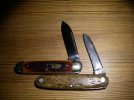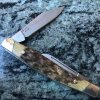- Joined
- Aug 15, 2013
- Messages
- 4,897
you prefer the steel that will rust in a sweaty pocket
Spoken like a true okie knife nut.
The BladeForums.com 2024 Traditional Knife is available! Price is $250 ea (shipped within CONUS).
Order here: https://www.bladeforums.com/help/2024-traditional/
you prefer the steel that will rust in a sweaty pocket
I like the fact with traditional slippies & lockbacks easy to use, good slicers & cutters & easy to maintain.
I like to sit of a night And hone up the knife I've used or am going to use the next day, part of the enjoyment of using a knife, well me anyway
As I'm partial to European & custom knives like laguioles & regionals. You get the option of carbon or stainless, easy to use & maintain.
I'm always looking at the possible next knife, I find the new breeds of Lionsteel, Fox & Viper
interesting as they look good. They all seem to favour M390 blades,
Qustion?
Why do slippies need a blade steel of 59 to 61Rc?
I'm not saying it's right or wrong. I've always been satisfied with carbon, tru sharp or 12c27 and the like. It's just something I've observed & curious what others think.
Cheers
mitch
P.S if this is controversial, sorry.

IIRC someone who works at GEC said 1095 puts far less wear on their equipment than stainless and that strongly factors into their decision to use 1095.
.................... when theres fish to catch, Guinness to drink and beer cans to plink with my granddaughter who's turned into a crack shot with a .22 Marlin.


 I am most envious, particularly the granddaughter who goes a plinkin' with you, so cool
I am most envious, particularly the granddaughter who goes a plinkin' with you, so cool 
 Last year's Forum Knife has not needed even stropping yet and I use it a lot. Carbon knives that are not even used seem to go dull, odd, perhaps it's surface rust on the edge?
Last year's Forum Knife has not needed even stropping yet and I use it a lot. Carbon knives that are not even used seem to go dull, odd, perhaps it's surface rust on the edge?
This is true, and why they don't do 440C anymore. We could easily assume that D2 won't happen either. GEC has a reputation for doing their process "old school" which is part of the attraction. They also just do a darn fine job of it.
Until recently that was my profession.Even the tradesmen out there doing kitchen and bath remodels are carrying Husky, Stanley, and Milwaukee brand folding utility knives with replaceable blades from Home Depot or Lower.
Maybe a proper modern 2 blade pocket knife needs a blade of 1095 and a blade of CPM154.
A modern hybrid all rounder.

That's me !we all probably know someone that reckons "nothing beats carbon"
ouThat's me !
I'm fine with the stainless , but I love patina and hold carbon knives a bit high since I can really only buy them online.
Maybe a proper modern 2 blade pocket knife needs a blade of 1095 and a blade of CPM154.
A modern hybrid all rounder.
Can we get a consensus around that!
ou
I'm hearing you.
All my knives are bought online, only retail option is overpriced sak or leatherman. Always looking for a bargin online
Most stainless laguioles and similar. are around 56rc for ease of maintenance.
Slipjoints don't need blades with an Rockwell hardness of 59-61.
